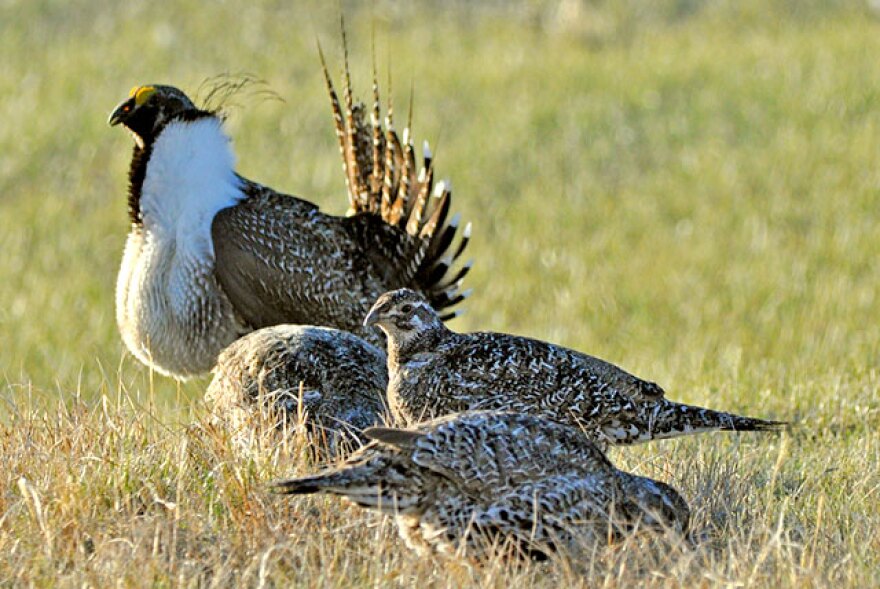The Department of Interior announced a proposal in May to convert mining claims to protect the sage grouse population in the West. Already there are 165 million acres of sage grouse habitat set aside nationwide. The latest proposal would set aside an additional 10 million acres.
“This is really a controversial issue,” said Terry Messmer, a professor of wildlife and conflict management at Utah State University. “It pits federal [government] versus state [government].”
On one hand the federal government is using their authority to protect sage grouse, but on the other hand Messmer said the 10 states involved, including Utah, see the proposal to restrict mining activity to protect sage grouse as overkill. If the federal government limits and restricts Utah’s mining potential, it could lose future business partners.
“The states are arguing that they don’t want to eliminate the possibility of restricting economic development in areas where we don’t have to,” he said.
As far as the federal government is concerned, Messmer said there are two elements of mining that can be destructive to sage grouse habitat. Mining is site specific, meaning there is a specific location where agencies are mining.

“If that location happens to be inhabited by sage grouse, you have immediate destruction,” he said.
At the same time, when you mine something, it has to go somewhere. As a result, mining agencies build roads and other infrastructure around the mine that can also infringe on sage grouse habitat. He said those areas can be used for habitat enhancement.
“In other words, you are mining an area,” he said. “But because of the mitigation associated with that mining, you can go into another area close by and you can create habitat.”
The way Utah is set up, sage grouse conservation groups, state wildlife agencies, and researchers help protect the sage grouse by using revenue from oil, gas and mining development, Messmer said.
“Because somehow you have to pay for this stuff,” he said. Messmer said he calls Utah's sage grouse protection plan a plan of shared pain, because policy makers have to effectively balance the right mix of sage grouse conservation with economic development.
“Shared pain is the idea that we all commit resources to identify issues,” he said. “We also, at the same time, commit resources to come up with solutions, but everybody pays for their part of the process.”
Messmer said he has been studying sage grouse since 1996 and a lot of the money that has been donated to researching and protecting the bird has come from private companies trying to maintain sage grouse habitat on their own land.
“The first check written to Utah State University to study sage grouse in Utah came from private landowners in Wayne county,” he said. “They were concerned about their sage grouse population. Now, their area is one of the most robust areas in terms of sage grouse population.”
The 10 million acres of the proposed land is spread throughout 10 states, so Utah is hardly affected, said Messmer. Under the proposal, there are 100-200 thousand acres of proposed sage grouse conservation land in Box Elder, and Rich counties included in the plan. Statewide there are about 7 and a half million acres currently included in sage grouse management areas, 50 percent of the area is owned by the federal government, 34 percent by private entities, 10 percent by state government, and 5 percent by tribes.
“Those areas represent the best potential for sage grouse populations,” he said.
Messmer said the governor has set aside several cabinet-level positions whose jobs are dedicated to finding the right balance of private development and conservation efforts. Their job is to go out and work with private individuals and with companies to investigate the impacts of potential projects.
The purpose of the agencies is to try to get as much bang for their buck as they possibly can, said Messmer. These agencies investigate these three questions: How much sage grouse protection is necessary to maintain the population? How much of that land can be used for private businesses? How can those two with seemingly opposite ideals work together?
“The state [sage grouse protection] plan is developed in such a way to ensure that we are using the best available science,” he said. “Because in a lot of these areas, the local economies are dependent on a lot of these activities.”
The public comment period ends Friday.
For more about sage grouse and Utah's mines, click here.






